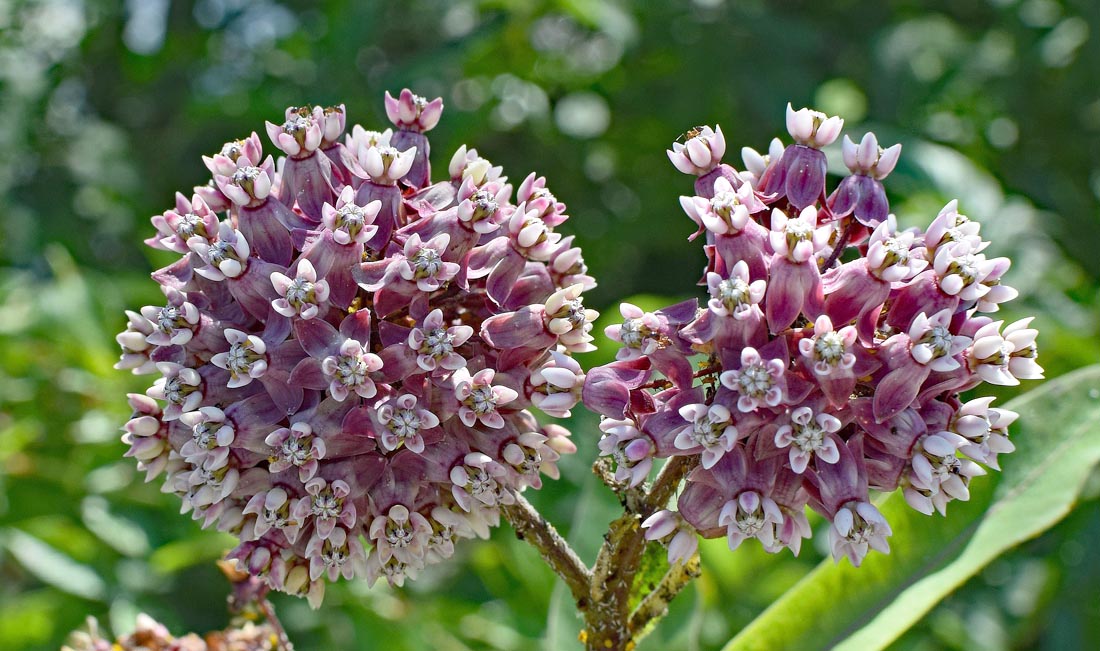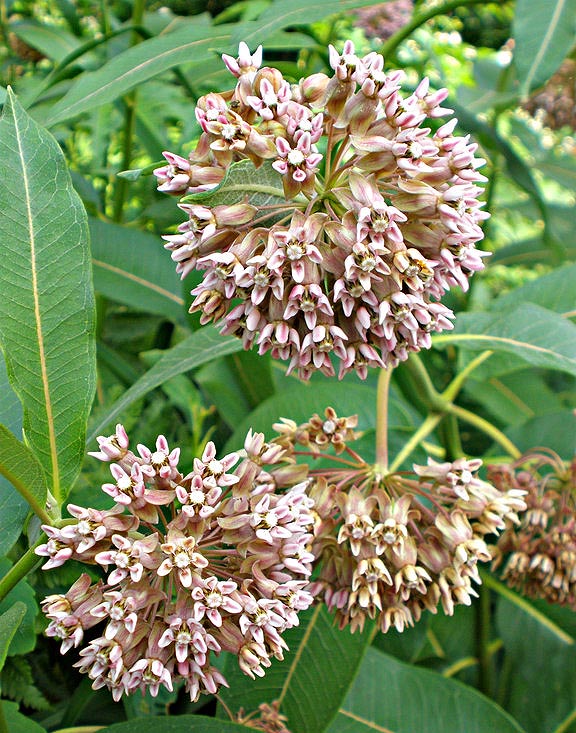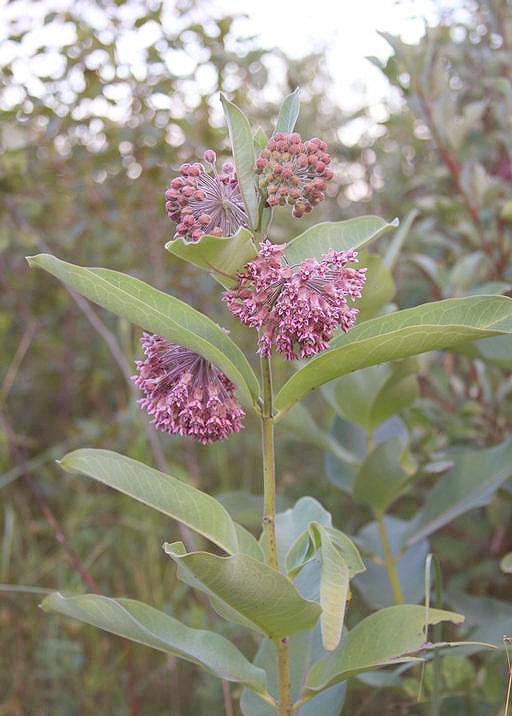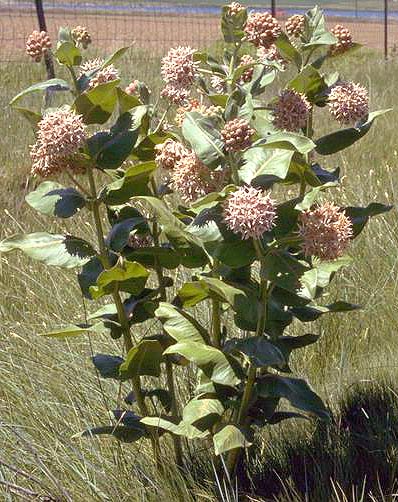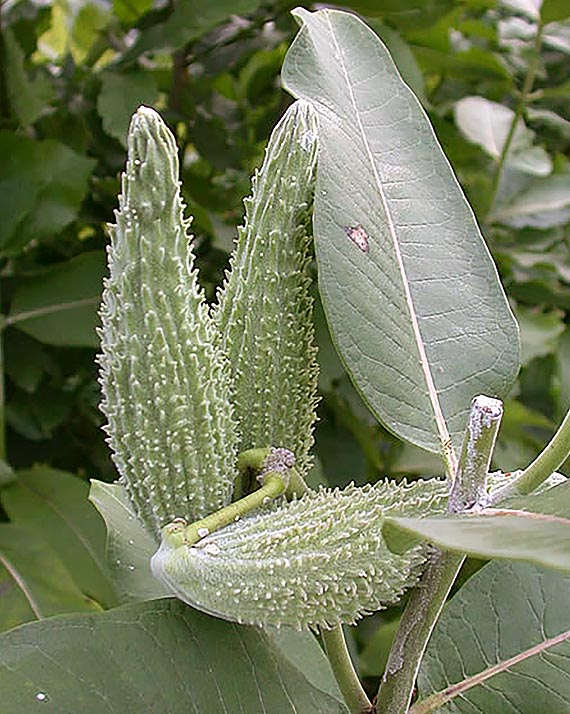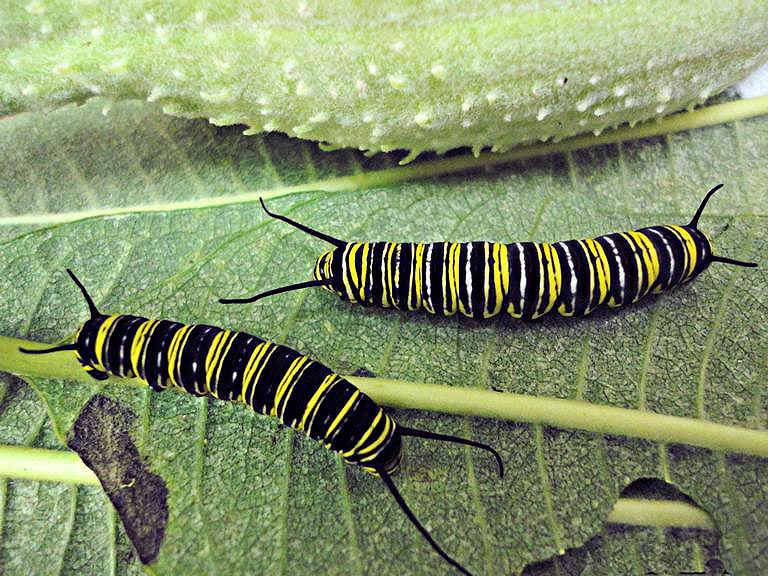Although its called Common milkweed it is now far less common than it used to be. Where once anyone who travelled country roads from Texas all the way to Canada would see these plants along the way today its almost impossible to find. Continual use of herbicides and removal of hedgerows and open spaces have reduced the population to tiny populations in few places. This has put one of our most beloved butterflies - the Monarch - at risk as it lays its eggs and its caterpillar feed on no other plant.
The good news is its pretty easy to grow once you get the seeds started. They are a little fiddly since they need a period of cold to germinate but once you have these magnificent plants its all worth it. Devote a patch of your garden to these lovely plants, under plant them with showy flowers that also attract butterflies and hummingbirds and you will be delighted with the show nature can provide.
Common milkweed is a tall native American perennial that grows from a fleshy tap root that does not like to be moved. So plant it and forget it. Once established it will produce large pink ball flowers every year for many years to come. Due to the nasty taste of the mature leaves deer and rabbits don't eat it. so all you need to do is enjoy the show and cut the dead stems down in the fall or early spring. Simple, easy and less work for you.
We also offer Swamp Milkweed (Asclepias Incarnata) a more clump forming perennial that likes wetter areas but will grow almost anywhere provided it has a little water; and Showy Milkweed (Asclepias speciosa) which is far more drought tolerant needs little water once established and has bigger flowers. Does not do as well in humid damp of south eastern states.
Description of Common Milkweed (Asclepias syriaca).
Common milkweed is a perennial that produces a fleshy taproot. Each spring it puts up one or more thick unbranched stalks the number will depend on the size of the taproot and age of the plant. Stems are hairy and support fairly large thick pairs of leaves from 4-8 inches (10-20.3 cm) long and 2-4 inches (5-10 cm) wide. Leaves can vary in shape from spear shaped to oval, lanceolate or elliptic and are rich dark green on top and lighter beneath due to a coating of fine hairs. Leaves are arranged in opposite pairs progressing alternately up the stem.
Flowers are best described as large golf balls on stalks. Technically they are called spherical umbels and are about 2 inches (5cm) in diameter and composed of about 30 flowers although as many as 100 individual flowers have been recorded. Each flowers is about 0.5 inches (1.2 cm) long and consist of five pink petals in an wide pentagon shape with noticeable stigma and stamens in the center. Flowers are followed by large seed pots up to 5 inches (12.7 cm) long. These are pale green and covered in bumps. The pods eventually turn brown, spilt open and release dozens sometimes hundreds of flat brown seeds on silky white 'parachutes' that ensure good wind dispersal.
Stems are normally about 3 feet (1 m) in height but in good conditions can grow as tall as 5 feet ( 1.5m). If any part of the plant is damaged it exudes a sticky white sap which is what gives these plants their name.
Growing Common Milkweed (Asclepias syriaca) from Seed.
While Common milkweed is fairly easy to grow it does need some special attention first. The seed needs to be moist stratified. Most sources also state that keeping the seed cold stratified before this helps greatly with germination, which is what we have also found. To that end we keep all our seeds very cold before they are shipped to you. However to get good results you still need to moist stratify them before they will give good germination rates. There are several different methods to do this. You can either plant them directly outside in late fall or early winter and let nature do the work or you can artificially create it yourself. This is not difficult but does take a little patience. See our
Stratification instructions for full details on the methods for doing this.
Seeding inside.
Follow the
Stratification instructions after choosing which method you want to use. We recommend that if possible you use small pots or individual cell trays to sow seeds. This way you can transplant seedlings as they grow without disturbing any seeds that have yet to germinate. Milkweeds need at least 30 days of cold stratification to germinate but much longer is great. If you want to seed your trays in winter and put them in a cold shed or garage until spring they will be fine. All milkweeds tend to create large tap roots and they don't like to be disturbed so growing in individual pots or even peat pots is recommended.
Once seeds have been removed from their cold treatment keep them in a cool environment to germinate. Do not put on heat pads or in a very warm place. Swamp milkweed will not germinate if the soil temperatures are over 85°F ( 29 °C).
Indoor sowing allows you to have much more control over your seedlings and where they are germinating before transplanting outside. Its also a lot easier to control weeds.
Direct sowing outside.
This can be done in late fall to early winter. Decide where you want the plants to grow and clear the area remove as many weeds and small roots that might be weeds as you can. Plant the seeds individually or in pairs spaced about 2-3 feet (61-91 cm) apart. Seeds can always be thinned after they have germinated. Lightly cover the seeds with soil and water in well. Ensure that the area does not dry out over the winter. If the weather is mild and dry add some water to the soil to keep it moist. The objective is to have the seeds get cold and even freeze of a period that will break the dormancy.
When spring comes keep checking the area and remove any obvious weeds. Don't pull anything you don't know what it is just in case). Keep as weed free as possible while seeds germinate and grow. Thin seedlings as necessary. You may want to try transplanting the seedlings but take care they don't like their roots disturbed that much.
Transplanting.
Harden seedlings off outside and slowly introduce them to full sunshine before planting out. Grow in small pots so that the roots will almost fill the pot before transplanting when the plant is about 3" (7.6 cm) tall as this will reduce the shock to the roots. Seedlings should be in individual pots. Don't water the plants for a day or more before transplanting to ensure that the soil remains together. Try to remove the whole of the soil mass and place in the transplant hole without disturbing the roots. Water well and keep moist. Even so the plants may take some time to recover from the transplant shock and may even loose some or all of their leaves. Don't despair most usually recover but occasionally there are some that don't.
Location and Care of Common Milkweed (Asclepias syriaca).
Chose your location carefully as plants do not like to be moved once established. An area with full sun is essential in colder zones (7a and colder) but partial to half shade is acceptable in warmer zones. Space plants at about 12-18 inches (30.4-45.7 cm). If growing in a border remember it can grow to 5 feet (1.5m) so plant towards the back. If growing for pollinators plant in groups. Often a plant will not have sufficient leaves for one caterpillar and it needs a second plant. If that pant is far away (by caterpillar standards) it may not be able to reach it before it dies.
If you did not use compostable pots and disturbed the roots when you transplanted the plant may drop all its leaves as it goes into shock. They hate having their roots disturbed. However in most cases once it has reestablished its roots it will begin to grow again but it will be far behind those that had healthy roots and plants may be stunted for years.
Milkweeds are not fussy about soil type but it must be well drained, does not survive in wet soils. Once established this plant takes very little care. cut down dead stalks in winter or early spring is all that really needed.
Water sparingly. Just keep the soil moist when plant are new but once its established and begins to take off maybe once a week if there is no rain and some watering in prolonged drought is all that will be needed.
POLLINATOR SAVE THE INSECTS
While Common milkweed is a lovely plant with showy flowers it has not been grown in gardens much until the plight of the Monarch butterfly was known. Sadly so many milkweed plants have been destroyed by the wide use of herbicides and hedgerows removed that the plant has fewer places to grow and thus no food for Monarchs.
If growing for Monarchs remember the caterpillars EAT the plant. So you need a lot of plants. One here and there will not to the job, you need a fairly large block of plants together so the butterflies can find them and the caterpillars don't starve if they eat out one plant. If they have to travel a long distance (by caterpillar standards) to find another plant they may die before they reach it. Keep other plants close at hand. It is also important to realize that your plants may be decimated by caterpillars and almost eaten to the ground. Offering far more material than they can eat ensures they have enough food and the plants have enough to recover and produce leaves for next year. One or two plants are not going to help and you many loose your plants if they get eaten out entirely.
Since Common Milkweeds are tall plants they can be grown in conjunction with other smaller plants beneath them to make an attractive pollinator garden. Things like alyssum, thyme or even larger plants like catnip, anise hyssop and other good pollinator plants can be mixed with them.
While Monarchs are one of the few butterflies that lay their eggs on the plant multitudes of others visit the flowers to feed on the nectar and pollen. Many other butterflies, native bees, moths and even hummingbirds visit the flowers. However the strong compounds in the leaves make it unpalatable to most wildlife so its deer and rabbit proof.
Culinary Uses of Common Milkweed (Asclepias syriaca).
Quite surprisingly these plants are edible - if harvested at the right time and cooked to remove any bitter compounds. The young flower buds are reported to taste like peas but also stated they are slightly mucilaginous and can be used to thicken soups and stews. young seed pods apparently taste like okra and the young shoots and shoot tips are like asparagus. Older leaves contain cardiac glycosides that are considered toxic in large amounts so its is essential that only young plant material is used. The seeds can be sprouted and eaten also.
The flowers having a very high nectar content can be boiled down in a syrup or reduced further into something like brown sugar.
Medical uses of Common Milkweed (Asclepias syriaca).
Long used by Native Americans as a herbal medicine. the leaves and latex are used to treat cancer and tumor and topically to treat warts although long term daily treatments are required for good results. The stems are also used as a poultice on rheumatic joints. The roots are used in low dosages for treatment of asthma, kidney stones and venereal disease, while pounded and carefully prepared it was used as a temporary contraceptive in women.
Other uses of Common Milkweed (Asclepias syriaca).
The tough stems can be used to make fiber for twine or cloth. The seed floss once had a far more important role as a insulator and was used to stuff pillows, mattresses and other items need stuffing. Because of its high water repellent nature it was also used in life jackets. the downside is that it is flammable and was used in the making of candlewicks. While highly water repellent it will soak up oil very quickly and is being considered to help removal of ocean oil spills. Latex can also be used to create a low grade rubber. Due to the diverse uses of one plant studies are being conducted to determine if this could be profitably raised as a crop.






